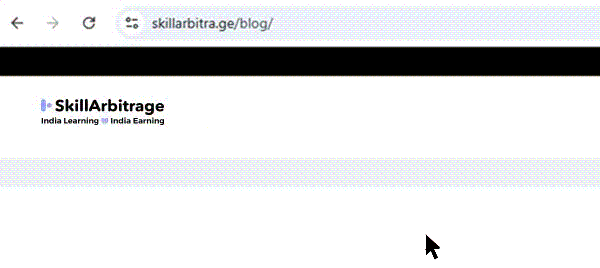This article is for solo founders, copywriters, and first-time entrepreneurs who want to test if their idea will work before building anything. It breaks down a 5-step system using AI and free tools to check demand, spot gaps, and get user feedback fast.
Table of Contents
Introduction
You can now test an idea in days, not weeks. You can check search demand, scan communities, generate test offers, and even talk to early users, all with a few free tools and the right prompts.
And yet, most people skip validation completely.
They fall in love with the idea, not the reality.
That’s one reason 90% of startups fail.
Not because they can’t build.
Because they built the wrong thing.
No market. No real pain point. No urgency.
Just a beautifully designed solution to a problem no one has.
It’s not incompetence. It’s hope.
Hope that if you just explain it better… design it cleaner… pitch it harder… it’ll click.
But markets don’t care how clever your deck is.
They care if the problem is real. And if you’re the one they trust to solve it.
That’s what validation does.
It replaces “I think” with “I know.”
It saves you from guessing. It saves you from building out of insecurity.
And with AI, you don’t need a team or a budget to do it.
You just need a method.
That’s what this guide is for.
Reasons for startup failure
Because 35% of them (CB Insights tracked this) built something no one wanted.
Not bad code. Not weak branding. Just… no demand.
Here’s the truth no founder wants to admit:
You need a lie detector
Something that tells you, fast, if the problem you’re solving is even a problem.
This is where AI changes the game. Not in the “write your business plan” fluff. In the dirty work like…
Testing if people search for it
Checking if competitors miss it
Running fake doors before you build anything real
This isn’t another blog telling you to “validate your idea” by asking your friends.
This is a 5-step process that uses free tools, cold traffic, and ruthless filtering. Tailored for:
- Solo founders (who can’t afford to waste 3 months on the wrong idea)
- Copywriters and marketers (who want to test niche offers fast)
- Freelancers (who want to package skills into products)
Startup failure 2025 infographic
What is business idea validation?
Let’s make something clear.
Your idea isn’t safe just because it’s clever. Or heartfelt. Or “fills a gap in the market.”
It’s only safe if people actually want it
And most don’t.
Forbes nailed this years ago: “The number one reason why start-ups fail was ‘no market need.’ In other words, there was no customer.”
So no, your clever idea isn’t special. Unless you prove it.
Business idea validation is just this: Can you prove that real people have real pain and are already trying to solve it?
Before code. Before branding. Before you spend ₹1 on ads.
Sounds simple. Almost too simple.
But founders skip it all the time. Why?
Because facing silence is brutal. Silence from Google. Silence from Reddit. Silence from your fake landing page with a waitlist of zero.
Business idea validation with AI
That’s where AI helps. Not by giving you answers. By forcing you to ask better questions. Fast.
You can’t afford a research team. Cool, ChatGPT becomes your brainstorming co-founder.
No SEO consultant? Plug your idea into Ubersuggest or Google Trends. It won’t lie.
For example, a solo founder wanted to build a generic fitness app. Boring.
AI + Trends showed a spike for “short workouts for moms” (KD 8, volume 300).
Boom, pivoted to 10-minute workouts for new moms. Clear pain point. Search volume. Real market.
That’s validation. Not “My friend said it was cool.” Not “I feel passionate about it.”
And if you’re thinking this is optional, go ahead. Build the thing.
Just don’t be shocked when no one shows up.
Step 1: Write a falsifiable 1-sentence idea
You don’t have a startup idea.
You have a vibe.
A wellness app.
A platform for creators.
A better CRM.
None of that means anything. It’s smoke.
And smoke doesn’t raise money. Or signups. Or even curiosity.
If you can’t explain your idea in one line that someone can say yes or no to, you’re not validating, it’s still fan fiction. Here’s the rule.
Business idea validation through AI-generated falsifiable statements
Make your idea falsifiable. Meaning someone should be able to say, “I’d never use that.”
If they can’t reject it, they can’t want it either.
That’s where AI pulls its weight. Not by dreaming up ideas for you (it’s bad at that), but by sharpening what you already have.
Try this prompt in ChatGPT:
Refine this vague idea into a 1-sentence pitch with a clear problem, target user, and result: [your idea]
Example:
Input: A freelancer app.
Output: A SaaS tool for freelancers to automate invoicing, saving 5 hours per week.
That sentence has meat in it.
It tells me who it’s for. What it does. Why it matters.
Compare that to… “It’s like LinkedIn but gamified.”
Or worse, “We’re building the next generation of human connection.” (You should be arrested for saying that.)
Avoid the buzzword soup
If you hear yourself saying “disruptive,” “platform,” or “fintech-for-X,” pause. Strip it down. Say what it does.
Budget-conscious founders don’t have time for branding exercises disguised as pitches. You’re not naming a perfume. You’re validating a business.
And if your idea can’t fit into one crisp, punchy sentence?
You don’t need feedback. You need clarity.
Step 2: Use AI and SEO tools to check demand
This is the part most founders skip.
They trust their gut. Or that one friend who said, “That’s genius.”
But your gut doesn’t scale. Search volume does.
If nobody’s Googling it? It’s not a business. It’s a diary entry.
Here’s how to check if anyone actually wants your idea. Fast, free, and without spinning up a prototype.
Start with Google Trends
It’s ugly. But gold. Plug in your idea. See if interest is rising, flatlining, or nosediving.
That solo founder who pivoted from a bloated fitness app to 10-minute workouts for new moms? Trends showed a clear spike. “Short workouts for moms” had consistent search volume. Seasonal but sticky.
Then stack the rest of supplementary business idea validation AI tools
- AnswerThePublic for real phrasing
- Ubersuggest or SEMrush for search volume
- ChatGPT to speed it up
Try this prompt:
Generate 20 long-tail keywords with search volume and buying intent for [your idea].
Example:
Original idea: “A freelancer tool.”
AnswerThePublic showed “how to automate invoicing” (KD 3, volume 100)
Google Trends confirmed “automated invoicing for freelancers” had steady demand (KD 5, volume 200)
What to look for while validating a business idea
- Search terms with KD (Keyword Difficulty) under 15
- Clear buying signals: “best,” “top,” “how to,” “software for”
- Patterns across tools, not one-hit blips
- Seasonality if it’s event-based (tax season? wedding months?)
High-intent keywords = oxygen for small teams trying to scale without burning ad money.
Low-KD = doors you can actually walk through.
Confession? Most “brilliant ideas” have zero search volume. None.
You’re not too early. You’re just alone.
So check demand. Don’t guess it.
Step 3: Analyze competitors with AI
You’re not here to copy. You’re here to find the crack in the wall.
Most first-time founders search for “top competitors in my niche” and then… copy-paste their features. Same pricing page. Same positioning. Same death sentence.
You don’t want to match the market. You want to hit where they’re blind.
AI-driven competitor research
List your top five competitors. Doesn’t matter if they’re bootstrapped or bloated. Feed their websites, pricing pages, and customer reviews into ChatGPT or Grok.
Prompt example:
Analyze these 3 competitors and suggest 3 unique angles for [idea]. Prioritize what they miss.
You’ll see patterns faster than a junior analyst on Adderall.
For example, when we ran invoicing tools through the prompt, one phrase kept popping up in reviews:
- “Confusing UI”
- “Too many options”
- “Not for beginners”
The hidden pattern? Most invoicing SaaS tools were built by developers for other developers. Non-tech freelancers like artists, writers, and yoga teachers felt locked out.
White space detected.
Now a solo founder can build an invoicing app with fewer buttons. Bigger fonts. Simple workflows.
Not sexy for TechCrunch. But deadly in Stripe revenue.
What to extract from competitor research
- Pain points from Trustpilot, G2, Reddit
- Features users actually love (not just what founders boast about)
- Pricing blind spots (are they ignoring solopreneurs?)
- Cultural tone mismatch (B2B tools speaking like a CFO, when the audience is creatives)
“We don’t have competitors” is a fantasy.
But “they all sound the same, so we’ll sound different” is a strategy.
Step 4: Build a no-code MVP using AI
Most people stall here. “I need a developer.” “I don’t know how to code.” “I’ll launch when it’s perfect.”
Stop. You don’t need perfect. You need proof.
The smartest founders don’t start with an app. They start with a landing page.
No-code MVPs let you test if people actually care without writing a single line of code. You just need two things: a sharp promise and a form that collects emails.
How to build your MVP fast
- Use ChatGPT to write your copy. Prompt:
“Write a landing page headline, 3 benefits, and a call-to-action for a [insert idea] targeting [insert user].” - Use Webflow or Durable to build the page. Templates make it dummy-proof.
- Use DALL·E or Midjourney to generate visuals that look polished enough to scroll.
One founder spent $50 on ads. The Webflow page pulled in 50 signups. That’s 50 people who didn’t need a full product to raise their hand.
How to test your MVP fast
- Write a 1-line pitch that hits a clear problem.
- Use AI to write the landing page — headline, subhead, benefits, CTA.
- Plug it into Webflow. Use a free template. Skip the branding.
- Add a form. “Join waitlist” is enough.
- Run basic traffic. Reddit, Twitter, cheap Meta ads. Budget: ₹2,000–₹4,000.
If no one clicks? Good. You saved months of your life.
If people sign up? Now you’ve got something real to build.
This isn’t hacking it together. This is the new stack.
Step 5: Get real feedback from users
AI is fast. Cheap. Sharp. But it can’t look confused while using your product. Real users can.
That’s the piece most solo founders skip. They run the whole race in their heads without asking if anyone’s waiting at the finish line.
You need live ammo. Real feedback from real people. Not your cofounder. Not your cousin. Strangers. Strangers with opinions. Strangers who might pay.
How to get feedback fast
- Pre-sell with a Stripe link or Gumroad page. If they buy, it’s validated. If they ghost, follow up and ask why.
- Post your mockup or landing page on Reddit subs like r/startups, r/EntrepreneurRideAlong, or even niche Facebook groups.
- Run a waitlist survey on LinkedIn. Or Twitter. Or email. Doesn’t matter where. Just get it in front of humans.
How to use AI to do market research
Let AI help. Prompt:
Generate a 5-question survey to test interest, price sensitivity, and top objections for [insert idea].
Even better, once you get those objections, ask AI to write your responses.
Draft a short reply for, “Is this secure enough for client billing?”
Done. Clear, confident, tested.
You don’t need a product to validate a product. You just need an offer people can respond to.
And here’s the uncomfortable truth. Silence is feedback. If they scroll past, bounce, or ignore the pitch, you’ve learned something.
Bonus : Validate founder-market fit with AI
Let’s talk about a quieter killer: founder–market misfit.
It’s not flashy. It won’t show up in keyword tools or ad dashboards. But it’s the reason brilliant ideas die with exhausted founders. The founder’s excited. The market is real. But they’re not the right person to build it.
They either hate the day-to-day… or suck at what the idea demands.
Here’s what most early founders never do: check if their skills match the business before they build it.
You can. Fast. With a prompt:
Based on these skills: [insert], what are my risks in building [idea]?
Example: a solo founder with a dev background planned to launch a SaaS invoicing tool. The AI flagged this: “Requires high-touch content marketing and customer onboarding.”
Translation? You need a marketer—or you’re gonna hate every week that isn’t writing code.
That saved him three months and a lot of silent weekends.
Now you’ve got three paths:
- Pivot to a version of the idea that fits you (e.g., dev tool for freelancers instead of B2C SaaS).
- Partner with someone who balances your blind spots.
- Upskill. But only if you’re ready to trade time for speed.
This isn’t just about efficiency. It’s survival. A solo founder who hates writing cold emails should not build a product that lives or dies by sales outreach.
AI can’t make you brave. But it can show you where you’re bluffing.
FAQs: validating your business idea with AI
- How long should the 5-step validation process take?
5 to 7 days is realistic.
- 1 day to refine your idea
- 1–2 days to check demand and competitors
- 1–2 days to build a no-code MVP
- 2–3 days to test feedback
Familiar with ChatGPT or Carrd? It’s faster. New? Budget extra time.
- How do I know if my MVP is good enough to test?
You don’t need polish. You need clarity.
If a stranger understands your offer in 5 seconds, you’re good.
Headline. Benefit. CTA. That’s enough. Use AI for visuals or copy if needed.
- When should I pivot or kill the idea?
No clicks after ₹2,000 in ads?
Fewer than 5% conversions from 100 visits?
Feedback shows zero urgency?
That’s your signal. Either reframe the core problem or move on.
- What if my idea has no search volume?
That’s not a green light. It’s a red flag.
Use ChatGPT to surface adjacent pain points that are being searched.
Then test a simplified version of your idea with a landing page or poll. No interest = no market.
- Can I validate an idea in a niche with no online communities?
Yes, but it’s slower.
Find nearby audiences (e.g., Reddit threads in adjacent categories).
Prompt ChatGPT to brainstorm creative entry points like LinkedIn, Discord, subreddits, and even offline meetups.
- What’s the minimum proof to say it’s validated?
Rough rules:
- 20–50 quality signups or survey responses
- 5–10 preorders or Stripe payments
- Feedback from actual buyers, not friends
Tight niches can get away with less, but the signal must be sharp.







 Allow notifications
Allow notifications
